Haiwen Diao
The Prism Hypothesis: Harmonizing Semantic and Pixel Representations via Unified Autoencoding
Dec 22, 2025Abstract:Deep representations across modalities are inherently intertwined. In this paper, we systematically analyze the spectral characteristics of various semantic and pixel encoders. Interestingly, our study uncovers a highly inspiring and rarely explored correspondence between an encoder's feature spectrum and its functional role: semantic encoders primarily capture low-frequency components that encode abstract meaning, whereas pixel encoders additionally retain high-frequency information that conveys fine-grained detail. This heuristic finding offers a unifying perspective that ties encoder behavior to its underlying spectral structure. We define it as the Prism Hypothesis, where each data modality can be viewed as a projection of the natural world onto a shared feature spectrum, just like the prism. Building on this insight, we propose Unified Autoencoding (UAE), a model that harmonizes semantic structure and pixel details via an innovative frequency-band modulator, enabling their seamless coexistence. Extensive experiments on ImageNet and MS-COCO benchmarks validate that our UAE effectively unifies semantic abstraction and pixel-level fidelity into a single latent space with state-of-the-art performance.
From Pixels to Words -- Towards Native Vision-Language Primitives at Scale
Oct 16, 2025Abstract:The edifice of native Vision-Language Models (VLMs) has emerged as a rising contender to typical modular VLMs, shaped by evolving model architectures and training paradigms. Yet, two lingering clouds cast shadows over its widespread exploration and promotion: (-) What fundamental constraints set native VLMs apart from modular ones, and to what extent can these barriers be overcome? (-) How to make research in native VLMs more accessible and democratized, thereby accelerating progress in the field. In this paper, we clarify these challenges and outline guiding principles for constructing native VLMs. Specifically, one native VLM primitive should: (i) effectively align pixel and word representations within a shared semantic space; (ii) seamlessly integrate the strengths of formerly separate vision and language modules; (iii) inherently embody various cross-modal properties that support unified vision-language encoding, aligning, and reasoning. Hence, we launch NEO, a novel family of native VLMs built from first principles, capable of rivaling top-tier modular counterparts across diverse real-world scenarios. With only 390M image-text examples, NEO efficiently develops visual perception from scratch while mitigating vision-language conflicts inside a dense and monolithic model crafted from our elaborate primitives. We position NEO as a cornerstone for scalable and powerful native VLMs, paired with a rich set of reusable components that foster a cost-effective and extensible ecosystem. Our code and models are publicly available at: https://github.com/EvolvingLMMs-Lab/NEO.
Regularizing Subspace Redundancy of Low-Rank Adaptation
Jul 28, 2025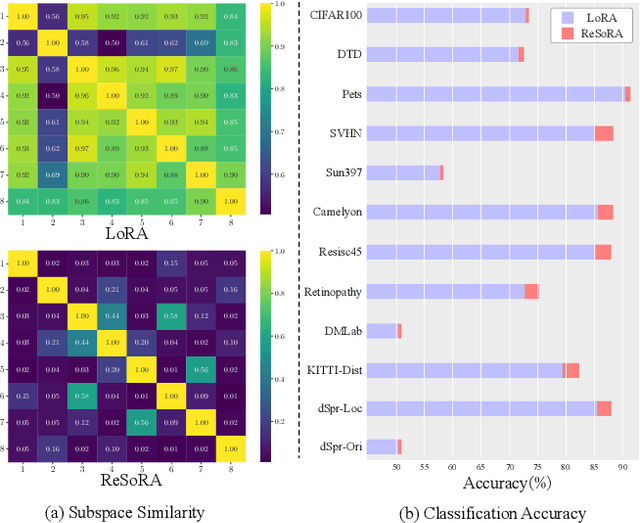

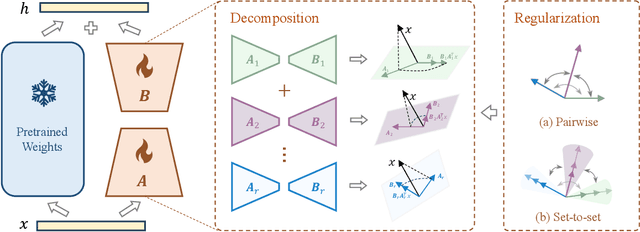
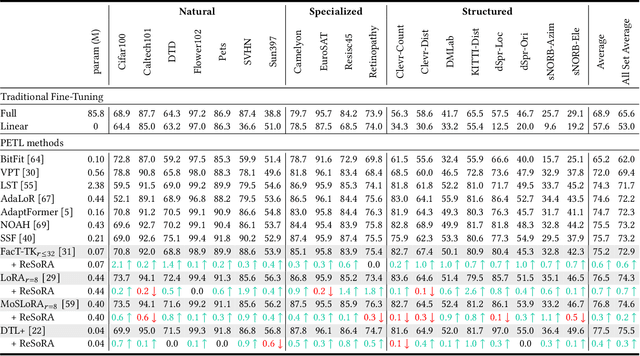
Abstract:Low-Rank Adaptation (LoRA) and its variants have delivered strong capability in Parameter-Efficient Transfer Learning (PETL) by minimizing trainable parameters and benefiting from reparameterization. However, their projection matrices remain unrestricted during training, causing high representation redundancy and diminishing the effectiveness of feature adaptation in the resulting subspaces. While existing methods mitigate this by manually adjusting the rank or implicitly applying channel-wise masks, they lack flexibility and generalize poorly across various datasets and architectures. Hence, we propose ReSoRA, a method that explicitly models redundancy between mapping subspaces and adaptively Regularizes Subspace redundancy of Low-Rank Adaptation. Specifically, it theoretically decomposes the low-rank submatrices into multiple equivalent subspaces and systematically applies de-redundancy constraints to the feature distributions across different projections. Extensive experiments validate that our proposed method consistently facilitates existing state-of-the-art PETL methods across various backbones and datasets in vision-language retrieval and standard visual classification benchmarks. Besides, as a training supervision, ReSoRA can be seamlessly integrated into existing approaches in a plug-and-play manner, with no additional inference costs. Code is publicly available at: https://github.com/Lucenova/ReSoRA.
End-to-End Vision Tokenizer Tuning
May 15, 2025Abstract:Existing vision tokenization isolates the optimization of vision tokenizers from downstream training, implicitly assuming the visual tokens can generalize well across various tasks, e.g., image generation and visual question answering. The vision tokenizer optimized for low-level reconstruction is agnostic to downstream tasks requiring varied representations and semantics. This decoupled paradigm introduces a critical misalignment: The loss of the vision tokenization can be the representation bottleneck for target tasks. For example, errors in tokenizing text in a given image lead to poor results when recognizing or generating them. To address this, we propose ETT, an end-to-end vision tokenizer tuning approach that enables joint optimization between vision tokenization and target autoregressive tasks. Unlike prior autoregressive models that use only discrete indices from a frozen vision tokenizer, ETT leverages the visual embeddings of the tokenizer codebook, and optimizes the vision tokenizers end-to-end with both reconstruction and caption objectives. ETT can be seamlessly integrated into existing training pipelines with minimal architecture modifications. Our ETT is simple to implement and integrate, without the need to adjust the original codebooks or architectures of the employed large language models. Extensive experiments demonstrate that our proposed end-to-end vision tokenizer tuning unlocks significant performance gains, i.e., 2-6% for multimodal understanding and visual generation tasks compared to frozen tokenizer baselines, while preserving the original reconstruction capability. We hope this very simple and strong method can empower multimodal foundation models besides image generation and understanding.
EVEv2: Improved Baselines for Encoder-Free Vision-Language Models
Feb 10, 2025



Abstract:Existing encoder-free vision-language models (VLMs) are rapidly narrowing the performance gap with their encoder-based counterparts, highlighting the promising potential for unified multimodal systems with structural simplicity and efficient deployment. We systematically clarify the performance gap between VLMs using pre-trained vision encoders, discrete tokenizers, and minimalist visual layers from scratch, deeply excavating the under-examined characteristics of encoder-free VLMs. We develop efficient strategies for encoder-free VLMs that rival mainstream encoder-based ones. After an in-depth investigation, we launch EVEv2.0, a new and improved family of encoder-free VLMs. We show that: (i) Properly decomposing and hierarchically associating vision and language within a unified model reduces interference between modalities. (ii) A well-designed training strategy enables effective optimization for encoder-free VLMs. Through extensive evaluation, our EVEv2.0 represents a thorough study for developing a decoder-only architecture across modalities, demonstrating superior data efficiency and strong vision-reasoning capability. Code is publicly available at: https://github.com/baaivision/EVE.
KARST: Multi-Kernel Kronecker Adaptation with Re-Scaling Transmission for Visual Classification
Feb 10, 2025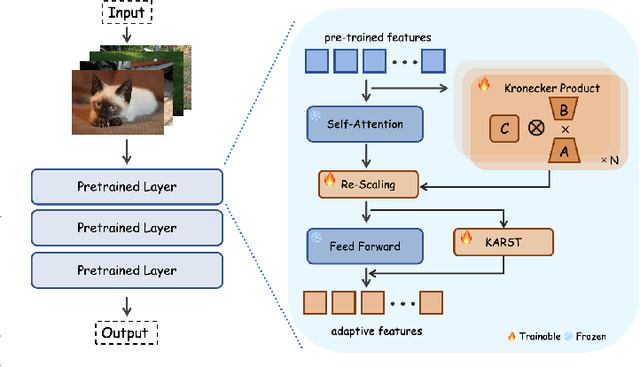

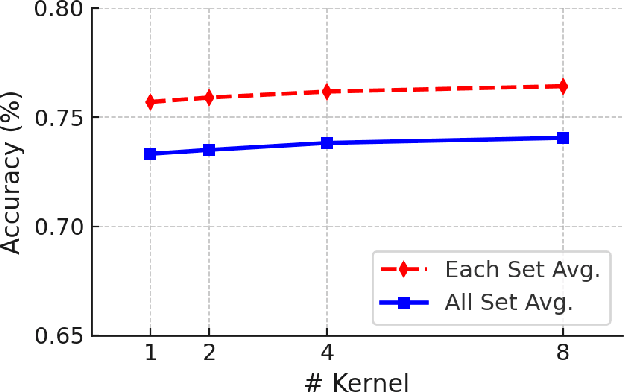
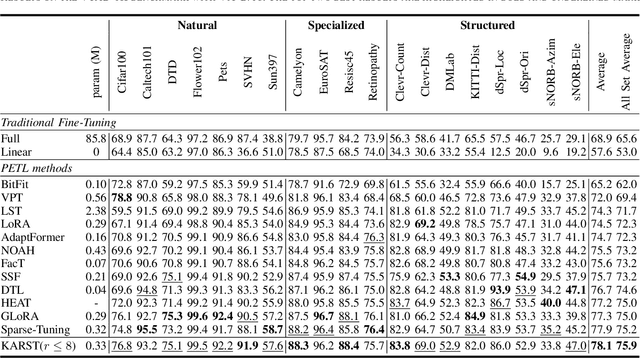
Abstract:Fine-tuning pre-trained vision models for specific tasks is a common practice in computer vision. However, this process becomes more expensive as models grow larger. Recently, parameter-efficient fine-tuning (PEFT) methods have emerged as a popular solution to improve training efficiency and reduce storage needs by tuning additional low-rank modules within pre-trained backbones. Despite their advantages, they struggle with limited representation capabilities and misalignment with pre-trained intermediate features. To address these issues, we introduce an innovative Multi-Kernel Kronecker Adaptation with Re-Scaling Transmission (KARST) for various recognition tasks. Specifically, its multi-kernel design extends Kronecker projections horizontally and separates adaptation matrices into multiple complementary spaces, reducing parameter dependency and creating more compact subspaces. Besides, it incorporates extra learnable re-scaling factors to better align with pre-trained feature distributions, allowing for more flexible and balanced feature aggregation. Extensive experiments validate that our KARST outperforms other PEFT counterparts with a negligible inference cost due to its re-parameterization characteristics. Code is publicly available at: https://github.com/Lucenova/KARST.
Autoregressive Video Generation without Vector Quantization
Dec 18, 2024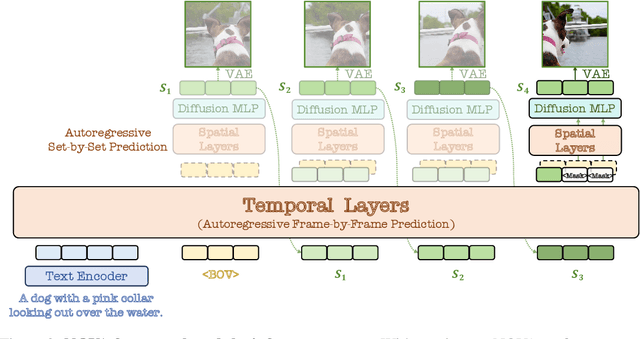
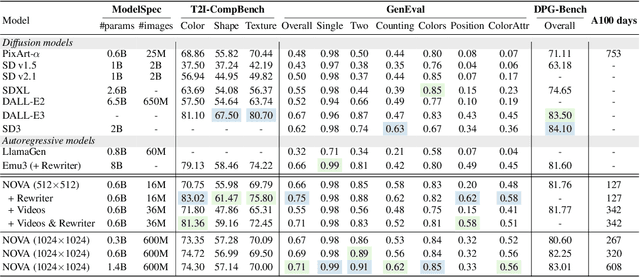

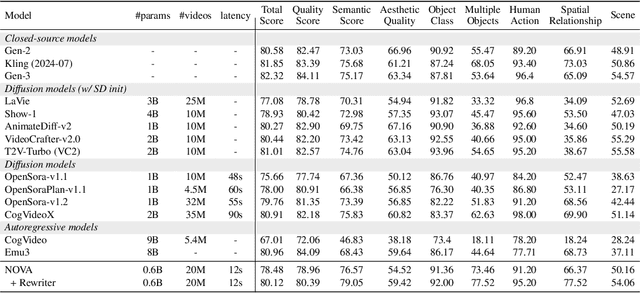
Abstract:This paper presents a novel approach that enables autoregressive video generation with high efficiency. We propose to reformulate the video generation problem as a non-quantized autoregressive modeling of temporal frame-by-frame prediction and spatial set-by-set prediction. Unlike raster-scan prediction in prior autoregressive models or joint distribution modeling of fixed-length tokens in diffusion models, our approach maintains the causal property of GPT-style models for flexible in-context capabilities, while leveraging bidirectional modeling within individual frames for efficiency. With the proposed approach, we train a novel video autoregressive model without vector quantization, termed NOVA. Our results demonstrate that NOVA surpasses prior autoregressive video models in data efficiency, inference speed, visual fidelity, and video fluency, even with a much smaller model capacity, i.e., 0.6B parameters. NOVA also outperforms state-of-the-art image diffusion models in text-to-image generation tasks, with a significantly lower training cost. Additionally, NOVA generalizes well across extended video durations and enables diverse zero-shot applications in one unified model. Code and models are publicly available at https://github.com/baaivision/NOVA.
MoTrans: Customized Motion Transfer with Text-driven Video Diffusion Models
Dec 02, 2024



Abstract:Existing pretrained text-to-video (T2V) models have demonstrated impressive abilities in generating realistic videos with basic motion or camera movement. However, these models exhibit significant limitations when generating intricate, human-centric motions. Current efforts primarily focus on fine-tuning models on a small set of videos containing a specific motion. They often fail to effectively decouple motion and the appearance in the limited reference videos, thereby weakening the modeling capability of motion patterns. To this end, we propose MoTrans, a customized motion transfer method enabling video generation of similar motion in new context. Specifically, we introduce a multimodal large language model (MLLM)-based recaptioner to expand the initial prompt to focus more on appearance and an appearance injection module to adapt appearance prior from video frames to the motion modeling process. These complementary multimodal representations from recaptioned prompt and video frames promote the modeling of appearance and facilitate the decoupling of appearance and motion. In addition, we devise a motion-specific embedding for further enhancing the modeling of the specific motion. Experimental results demonstrate that our method effectively learns specific motion pattern from singular or multiple reference videos, performing favorably against existing methods in customized video generation.
LLMs Can Evolve Continually on Modality for X-Modal Reasoning
Oct 26, 2024Abstract:Multimodal Large Language Models (MLLMs) have gained significant attention due to their impressive capabilities in multimodal understanding. However, existing methods rely heavily on extensive modal-specific pretraining and joint-modal tuning, leading to significant computational burdens when expanding to new modalities. In this paper, we propose PathWeave, a flexible and scalable framework with modal-Path sWitching and ExpAnsion abilities that enables MLLMs to continually EVolve on modalities for $\mathbb{X}$-modal reasoning. We leverage the concept of Continual Learning and develop an incremental training strategy atop pre-trained MLLMs, enabling their expansion to new modalities using uni-modal data, without executing joint-modal pretraining. In detail, a novel Adapter-in-Adapter (AnA) framework is introduced, in which uni-modal and cross-modal adapters are seamlessly integrated to facilitate efficient modality alignment and collaboration. Additionally, an MoE-based gating module is applied between two types of adapters to further enhance the multimodal interaction. To investigate the proposed method, we establish a challenging benchmark called Continual Learning of Modality (MCL), which consists of high-quality QA data from five distinct modalities: image, video, audio, depth and point cloud. Extensive experiments demonstrate the effectiveness of the proposed AnA framework on learning plasticity and memory stability during continual learning. Furthermore, PathWeave performs comparably to state-of-the-art MLLMs while concurrently reducing parameter training burdens by 98.73%. Our code locates at https://github.com/JiazuoYu/PathWeave
GSSF: Generalized Structural Sparse Function for Deep Cross-modal Metric Learning
Oct 20, 2024Abstract:Cross-modal metric learning is a prominent research topic that bridges the semantic heterogeneity between vision and language. Existing methods frequently utilize simple cosine or complex distance metrics to transform the pairwise features into a similarity score, which suffers from an inadequate or inefficient capability for distance measurements. Consequently, we propose a Generalized Structural Sparse Function to dynamically capture thorough and powerful relationships across modalities for pair-wise similarity learning while remaining concise but efficient. Specifically, the distance metric delicately encapsulates two formats of diagonal and block-diagonal terms, automatically distinguishing and highlighting the cross-channel relevancy and dependency inside a structured and organized topology. Hence, it thereby empowers itself to adapt to the optimal matching patterns between the paired features and reaches a sweet spot between model complexity and capability. Extensive experiments on cross-modal and two extra uni-modal retrieval tasks (image-text retrieval, person re-identification, fine-grained image retrieval) have validated its superiority and flexibility over various popular retrieval frameworks. More importantly, we further discover that it can be seamlessly incorporated into multiple application scenarios, and demonstrates promising prospects from Attention Mechanism to Knowledge Distillation in a plug-and-play manner. Our code is publicly available at: https://github.com/Paranioar/GSSF.
 Add to Chrome
Add to Chrome Add to Firefox
Add to Firefox Add to Edge
Add to Edge